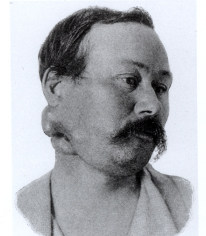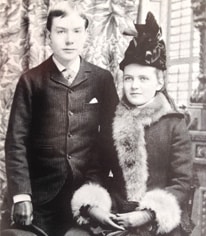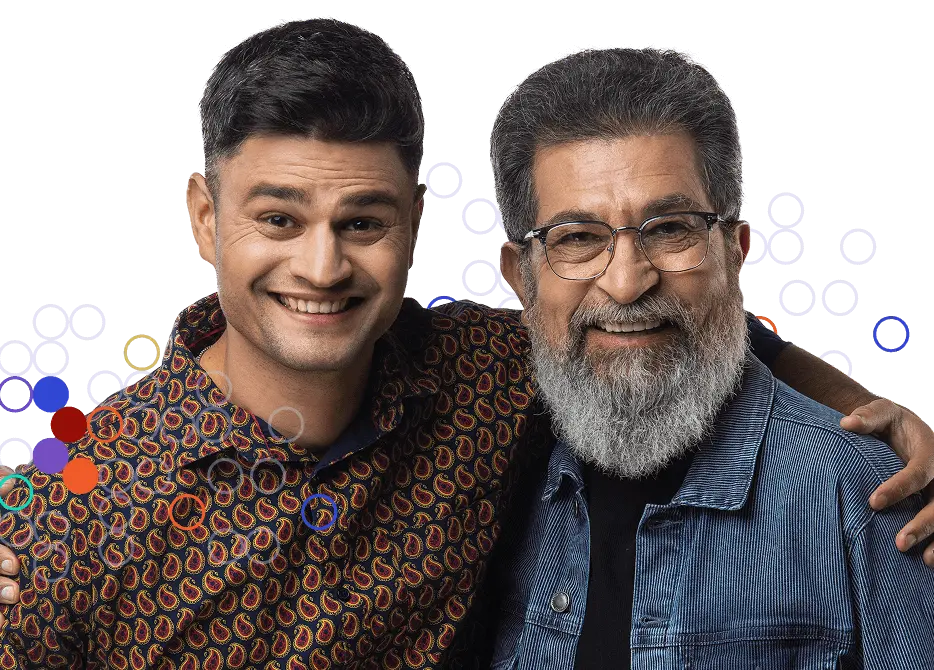In the summer of 1890, a young woman named Elizabeth (“Bessie”) Dashiell got her hand caught between the seats of a passenger train car while traveling on vacation. Over the next few weeks, she noticed that her hand became increasingly sore at the site of injury. Eventually, when the pain persisted for more than a month, she visited a doctor by the name of William Coley in New York City.
Coley, who was then 28 and a newly practicing surgeon, performed a biopsy expecting to find an infection, but he found no signs of pus or inflammation. Instead, he discovered that his 17-year-old patient had an aggressively growing bone tumor called a sarcoma. The cutting edge of treatment for this type of cancer called for amputation of the limb. Bessie had her arm amputated below the elbow in November 1890. Despite this drastic measure, the cancer continued to spread, eventually riddling her body with painful tumors. Bessie died in January of 1891, at the age of 18.
Bessie Dashiell’s story might have been lost to history, as have the stories of so many cancer victims over the centuries. But Bessie‘s tragedy served as the catalyst for the work of two influential individuals without whom we would not have the cancer treatments we have today.
The first person we have already met: William Coley. Coley was trained as a surgeon, but the depressing experience with Bessie Dashiell inspired him to search for a better way to treat this cancer. He was led to hospital records at the New York Hospital where he pored through past case histories until he found something interesting: the case of a patient named Stein, a German immigrant who had been treated with surgery for a cancer very similar to Bessie’s. Instead of succumbing to the disease, however, the man walked out of the hospital disease free.
Coley learned that the patient had come down with a severe post-operative skin infection called erysipelas and developed a high fever (such infections were common in the days before antibiotics). The man nearly died from the infection, but eventually his body mustered an immune response to fight it. Coincidently, the man’s tumor shrank down to nothing and he left the hospital days later, with no trace of disease. He was still alive years later when Coley tracked him down in his neighborhood on the Lower East Side.
 Coley surmised that the bacterial infection had somehow caused the tumor to regress, perhaps through the release of a “toxin.” He combed through the literature and found other cases of such spontaneous remissions that seemed to coincide with a case of erysipelas. Coley decided to test whether purposely infecting patients with erysipelas could cause their tumors to regress. He performed the first of these inoculations in 1891, on a patient named Zola, an Italian immigrant with a tumor “the size of a small hen’s egg” in his right tonsil, who likely had only weeks to live. To Coley’s astonishment, the experiment worked: the man’s cancer regressed completely and he lived another 8 years. This was the birth of immunotherapy.
Coley surmised that the bacterial infection had somehow caused the tumor to regress, perhaps through the release of a “toxin.” He combed through the literature and found other cases of such spontaneous remissions that seemed to coincide with a case of erysipelas. Coley decided to test whether purposely infecting patients with erysipelas could cause their tumors to regress. He performed the first of these inoculations in 1891, on a patient named Zola, an Italian immigrant with a tumor “the size of a small hen’s egg” in his right tonsil, who likely had only weeks to live. To Coley’s astonishment, the experiment worked: the man’s cancer regressed completely and he lived another 8 years. This was the birth of immunotherapy.
Coley continued to experiment with his “toxin” therapy for the next 30 years, achieving lasting remissions in some cases. While Coley was convinced of the value of his toxins, others were more skeptical.
The American Medical Association published an editorial in 1894 discrediting the therapy, and as the years passed, Coley’s toxins largely fell out of use, eclipsed first by radiation and then by chemotherapy. Coley’s contribution might have been forgotten completely if not for Coley’s daughter, Helen Coley Nauts, who re-discovered her father’s work after his death, and founded the Cancer Research Institute to rehabilitate his legacy.
In a very real sense, then, immunotherapy owes its existence to the profound effect that Bessie Dashiell had on William Coley.
 But that wasn’t the end of her influence. Bessie Dashiell also happened to be friends with the only son of John D. Rockefeller, founder of Standard Oil and perhaps the richest men in America at the time. John D. Rockefeller Jr. was a quiet, somewhat shy kid who avoided the limelight his family often attracted. He met Bessie through one of her older brothers and they hit it off immediately. John referred to Bessie as his “adopted sister.”
But that wasn’t the end of her influence. Bessie Dashiell also happened to be friends with the only son of John D. Rockefeller, founder of Standard Oil and perhaps the richest men in America at the time. John D. Rockefeller Jr. was a quiet, somewhat shy kid who avoided the limelight his family often attracted. He met Bessie through one of her older brothers and they hit it off immediately. John referred to Bessie as his “adopted sister.”
John was devastated by the death of his friend. He was supposed to be heading off to college at Yale that year, but was too distraught to attend. (He eventually attended Brown, where he was known affectionately as “Johnny Rock.”)
The tragedy inspired John to take a strong interest in supporting cancer research. Asked later about his interest in philanthropy, he said, “I think it goes back to Bessie Dashiell … Her death came to me as a great shock.”
At his son’s urging, John Sr. became an early benefactor of Memorial Hospital, where Bessie had been treated. Memorial was the first hospital in the United States devoted solely to cancer treatment. In 1939, Memorial moved east to its present site on York Avenue, on land donated by John D. Rockefeller Jr. In 1945, Charles Kettering and Alfred Sloan, titans of General Motors, donated money to expand the campus and create the Sloan-Kettering Institute, forming the Memorial Sloan-Kettering Cancer Center, now one of the premiere cancer centers in the country. John Jr.’s third son Laurance joined the board of MSKCC in 1947 and served as its chairman for 22 years.
 The Rockefellers shared a belief that basic scientific research was the key to social progress and human betterment (not to mention economic prosperity). In 1901, the family established The Rockefeller Institute for Medical Research, now The Rockefeller University, expressly for the purpose of using biomedical science to understand and conquer disease. Its motto is Scientia pro bono humani generis (“Science for the benefit of humanity”). Rockefeller, located on the east side of Manhattan, is where many of the most important advances in molecular biology and cancer biology were made, from Peyton Rous’s discovery in 1911 of viruses that cause cancer, to Oswald Avery, Colin MacCleod, and Maclyn McCarty’s discovery in 1944 that DNA is the hereditary material, to Ralph Steinman’s discovery of dendritic cells in the 1970s.
The Rockefellers shared a belief that basic scientific research was the key to social progress and human betterment (not to mention economic prosperity). In 1901, the family established The Rockefeller Institute for Medical Research, now The Rockefeller University, expressly for the purpose of using biomedical science to understand and conquer disease. Its motto is Scientia pro bono humani generis (“Science for the benefit of humanity”). Rockefeller, located on the east side of Manhattan, is where many of the most important advances in molecular biology and cancer biology were made, from Peyton Rous’s discovery in 1911 of viruses that cause cancer, to Oswald Avery, Colin MacCleod, and Maclyn McCarty’s discovery in 1944 that DNA is the hereditary material, to Ralph Steinman’s discovery of dendritic cells in the 1970s.
The Rockefellers also played a direct role in the birth of the Cancer Research Institute. In the wake of Bessie Dashiell’s death, John Jr. provided financial support to William Coley’s research on nonsurgical treatments for cancer, and the two remained lifelong friends. Much later, Nelson Rockefeller, John Jr.’s second son, provided $2,000 in seed money to Helen Coley Nauts for the creation of the Cancer Research Institute, which opened its doors in 1953. (CRI has since re-paid the debt, and then some, awarding more than $25 million to Rockefeller and Memorial Sloan-Kettering over the years.)
Before he died in 2004 at the age of 94, Laurance Rockefeller chronicled his family’s philanthropic investments in biomedical research, including the creation of two of the world’s finest medical institutions. That book is called, fittingly, The Legacy of Bessie Dashiell.
For more on Bessie Dashiell and the Rockefeller connection, as well as the history of immunotherapy more generally, see the engagingly written book, A Commotion in the Blood, by Stephen S. Hall.
